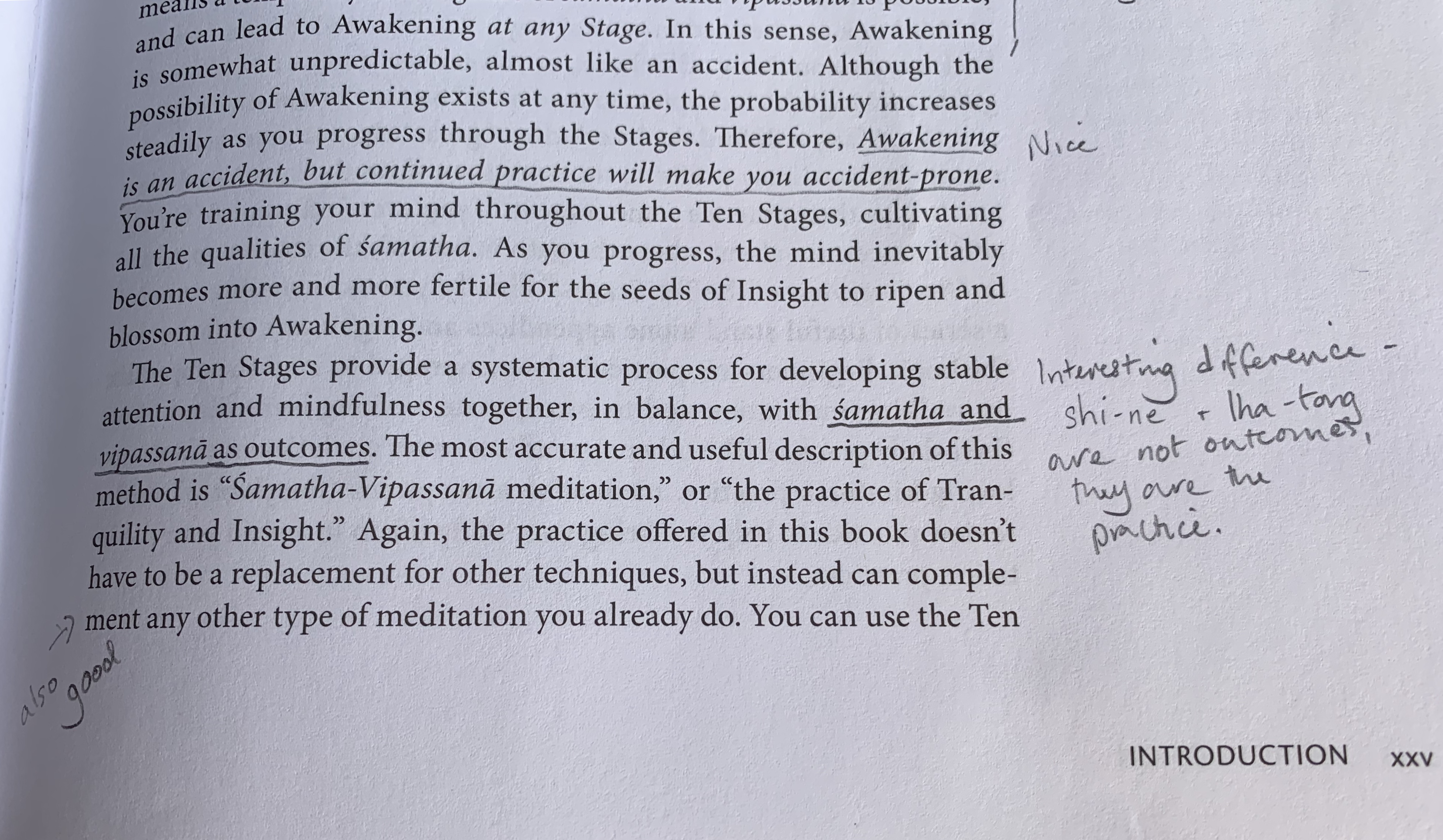
These are reflective notes on my experience of practicing Culadasa’s 10 stage meditation system. The notes in this post are from my third day of practice in the system. For an introduction to this project, see this page. Occasionally I will post-edit the journal. Any post editing is [in square brackets like this].
Re my note in the margin pictured above: ‘shi-ne’ and ‘lhatong’ are the Tibetan equivalents of the Pali ‘samatha’ and ‘vipassana’. Despite that, they describe specific meditation practices in the four naljor system, not outcomes of practice.
The book has an overview of the ten stages. From the overview section:
Mastery of stage 2 is “you can sustain attention on the meditation object for minutes, while most periods of mind-wandering last only a few seconds”. Mastery of stage 3 is “rarely forgetting the breath or falling asleep.”
The skills for stage 3 include labelling and checking in, which I’ve not used before. I’m finding that focusing on the breath is tending to correlate with my mind seeming duller than usual, so I’m going to experiment with the labelling today. Labelling involves “identifying a distraction with a simple label the moment you realize you are no longer focusing on the breath.”
Following the breath is described as “identifying specific events in the breath cycle, as well as all of the distinct sensations in the course of each in and out-breath. By creating a challenge, and therefore creating more interest in the events of the breath cycle, this type of in-close investigation helps to counter the natural tendency for attention to shift.” (Glossary, pg. 423) This is an investigative, somewhat more analytic approach than simply watching/observing the breath, so I’ll make a point of employing this technique.
I’ll wait until I’ve read the detailed chapters on stage 2 and 3 before moving on.
Day 3
40 minute sit:
- Maintained focus on the breath throughout.
- Noticed my breath changed considerably while having a coughing fit.
- Noticed the thought arise: “supposing I had something to label, what sort of a label should I use?”. Labelled it “thought about searching for a label,” instantaneously having the realization this could become an infinite recursion. Labelled that thought “meta-analysis of the infinitely recursive potential of thought-labellization,” then, labelled that one “mocking the practice”, then I labelled that “trying to be serious” and subsequently made the decision to stop labelling. I remained mindful of the breath during this process. I noticed a division of focus. It did feel like a division – ie, that my focus was ‘in two places’: the labelling place and the breath. Noticed a slight mental discomfort/dislike of this experience.
- At the moment, the concentrative experience still feels ‘less’ than the expansive one. I don’t find that surprising and don’t particularly mind it. It’s more ‘calm’ inducing than ‘clear’ inducing at this point.
After sitting I read the overview of stage 4. ‘Gross distraction’ and ‘alternating awareness’ are explained. Gross distraction: “when some mental object or sensory object becomes the primary focus of attention and pushes the meditation object into the background but not out of awareness.” (Glossary, pg. 423).
My experience so far is that the practice itself induces the states of mind it purports to address. For example, divided attention came as a result of labelling; my mind is somewhat duller resulting from a limited sphere of concentration. This may be because I’m approaching the system ‘backwards’. It’s interesting, anyway.
I guess I’ll drop the labelling if it takes my awareness away from the main point of focus. Not sure I need it. I don’t think it’s mentioned beyond stage 4 in the overview.
45 min sit:
- I’m having trouble closing my eyes, still can’t do that yet. 25 years of sitting with them slightly open and they just won’t close. I think I sleep like that too, so I guess the muscles in the eyelids have stopped sending them all the way down. I have a hunch this may matter for the full experience of this kind of concentrative practice, so I’ll keep at it. In shi-ne meditation, letting some light in functions to keep you alert and helps maintain awareness in connection with the environment & senses. The slightly open eyes encourage expansive awareness. I need to let go of that so the concentration can function however it’s supposed to.
- Noticed that concentrating closely on the breath is playing havoc with my proprioception. My nose went off to the left of my face at one point. My breath wasn’t in my nose, the nose was somewhere else, etc. I just let the nose do whatever and stayed with the breath. Felt like a Picasso.
- Also, closing my eyes and bringing the concentration focus so close to my physical face is causing a little shift in facial and neck posture, producing slight tension: small muscle spasms at the back of my head-neck joint and jaw. Mild ache behind the eye.
- Strong sense of a line of pressure going up through the top of the nose. Felt pressure at the top back of my head.
- I’m having occasional thoughts arise ‘in the background’. They’re noticeably dull. The whole experience is a bit cotton-woolish, actually. I could just decide to move outwards into ne-pa (presence of awareness with absence of thought) but that’s a different practice, so I’m remaining uninvolved with the dull occasional thoughts & maintaining a concentrated focus on the breath.
- Message app pinged while I was sitting. The sound was definitely ‘somewhere else,’ like there was a ‘background’ to my field of awareness. Again, a very different experience to four naljors.
40 min sit:
- Very calm.
- Still some muscular tension from the shift to concentrative focus.
- Mild tingly warmth across back top part of head throughout the sit. At times this spread to shoulders, arms & chest.
